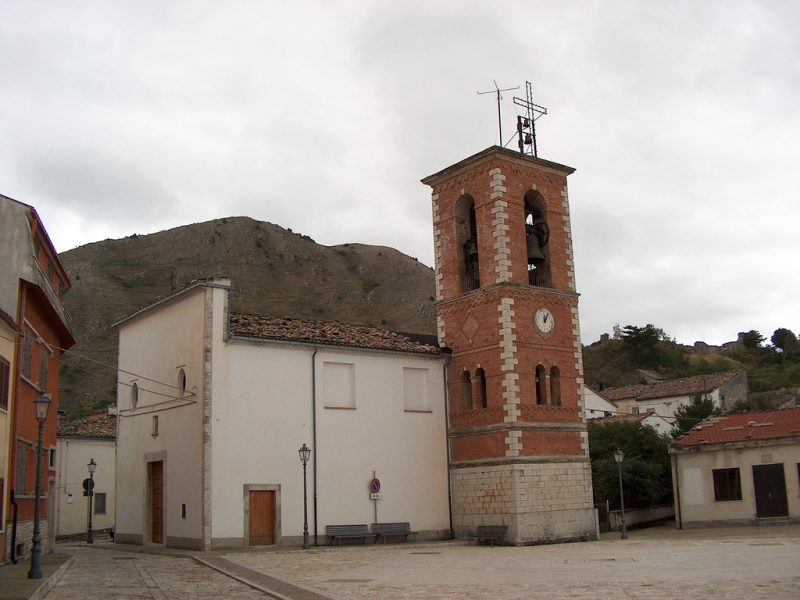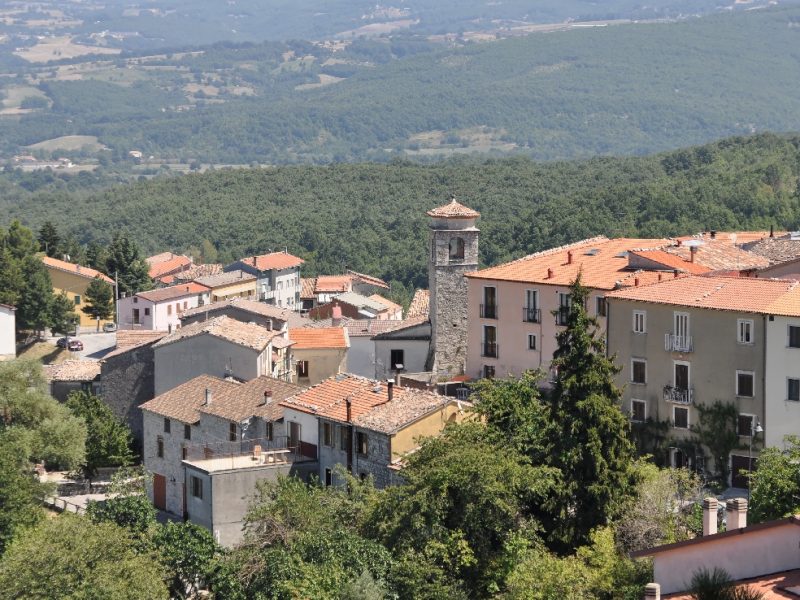The Borgo of Termoli
Your gaze is swept away by the infinite blue surrounding Termoli, its ancient stone borgo perched over wooden fishing piers and golden sand beaches. The sea breeze narrates stories and legends, faithfully guiding the fishermen back to shore. They are men of honor, men of heart, whose sacrifices built the Cathedral, which shines in the heart of the historical center, dedicated to San Basso, protector of the city. All the ancient lanes of the old city start and finish at the Cathedral, faithful custodian of the Ducal Palace and the magnificent city gates.
The ancient borgo of Termoli is joined to the new city by Corso Nazionale, the silent expanse of the sea setting a romantic scenario for their eternal love.
Sunset falls upon fishing boats cradled by the waves, tingeing the boardwalk with gold, and washing the peaceful houses in an amber light. As the moon rises in the sky, dinner time arrives, and in Termoli, the perfect way to conclude the day is with a hearty fish soup, prepared with the fishermen’s catch of the day.
History
The Molise region has access to the Adriatic mainly thanks to Termoli and its old city, which is set on a rocky promontory overlooking the sea.
Archeological excavations have brought to light an ancient prehistoric necropolis, testifying the presence of human settlements as early as the sixth century BC, and yet, today there are no certainties regarding the origins of Termoli or the etymology of its name.
One of the most accredited hypotheses maintains that the name ‘Termoli’ could be derived from a Greek noun meaning ‘city on the border’. This term may have been introduced by the Benedictine priests of Montecasino, who governed the fief, and who considered Termoli as the northernmost point of Puglia, on the border of Abruzzo. Another theory claims that the name is derived from ‘Torniola’, the name given to the borgo by a group of exiles fleeing from the city of Clitorniola, who settled on the promontory after escaping the invasion of the Goths. Any certainties existing about the origins of the borgo were lost forever in 1566, when the Saracen Turks besieged the city and destroyed the city archives and all its documents.
Historical certainty begins in 568 AD, when the Lombards arrived in Italy and founded the Duchy of Benevento, nominating Termoli as the capital of one of the thirty-four counties. The borgo overlooking the sea was a weak point in the defensive system, and so a protective city wall was constructed with a central tower and eight towers along the wall.
When Termoli became part of the Kingdom of the Two Sicilies, it was first governed by the Normans and then the Swabians. At the behest of Federico II of Swabia, a castle was constructed in the borgo, the walls were strengthened and expanded and a weekly market was established, held every Monday.
The borgo of Termoli remained confined inside its city walls until 1849, when King Ferdinand of the Bourbons granted the population permission to build outside the walls, also authorizing the construction of two roads: Corso Nazionale e Corso Umberto. For Termoli, these events heralded the beginning of the modern age.
The advent of new constructions led to an increase in the population and important developments for the borgo, culminating in 1910, with the construction of the port. This flourishing period came to an abrupt halt in the early 1900’s, when the two World Wars undermined the stability of the borgo. During WWI, the city was bombed twice by Austrian ships, and in WWII, Termoli became a theater of war for clashes between British and German forces.
After the Second World War, the city rediscovered the road toward growth and development, thanks to the establishment of an industrial sector, which created new jobs.
In the last few years, Termoli has been confirmed as one of the favorite destinations for both seaside and cultural tourism, and the inhabitants of the borgo welcome their visitors with pride.
Cattedrale di Santa Maria della Purificazione
The Cathedral represents the historical memory of Termoli, its façade and interior recounting the tumultuous adventure of the town’s long existence.
The cathedral stands on the highest point of the city, a key witness to Termoli’s important role in the past as a rest stop for pilgrims on their way to the Sanctuary of San Michele in Puglia before departing for the Holy Land.
The existing cathedral dates back to the 12th-13th century, and was constructed on the foundations of a pre-existing church built between the 6th and 7th centuries.
In 1456, a violent earthquake collapsed the upper section of the façade, which was restored with recuperated material. The church also suffered greatly from the Barbarian invasions which constantly disturbed the peaceful village over the centuries. The most terrible invasion of all was by the Saracens in 1566, when one hundred Turkish galleons arrived and practically razed the city to the ground.
The entire structure of the Cathedral has undergone numerous restorations, but the façade is the part that has remained the most faithful to the original construction. It is in Apulian Romanesque style, with influences dating back to other eras. An elegant stairway leads to the main entrance, distinguished by a portal with seven arches, and sculpted on the central lunette is the scene of Jesus admonishing the merchants in the temple. Flanking the portal are the statues of San Basso and San Sebastian, represented in the act of stomping on figures symbolizing heresy.
The upper part of the façade is of a more recent construction, with arches on the side. The center is decorated with a rose window that was added, together with a large window, in 1961.
The interior has three naves with three apses, but retains very little of the original construction. Over the centuries, the Apulian Romanesque style made way for other influences, such as the Baroque style introduced by the acting bishop at the beginning of the 1700’s.
In 1885, the Cathedral became a national monument.
In 1945, the relics of San Timoteo were discovered in the Cathedral. It is said that they were hidden in 1239 by the bishop at the time to protect them from being stolen by the Venetians, who were aggressively raging through Southern Italy in that period.
Castello Svevo, the Swabian Castle
During the Turkish invasion of 1566, all the documents attesting the origins of the castle were destroyed, so only hypotheses can be formed regarding the year of construction. There are visible influences from the Norman and Swabian eras, as well as the partial ruins of a tower that probably dates back to the Lombard period.
In 1240, an invasion by the Venetians seriously damaged the castle, and Federico II ordered its reconstruction, which is why it is known as ‘Castello Svevo”. Later, the fortress again suffered extensive damage from an earthquake during the Aragon period.
The castle was built for defensive purposes and was embedded in the city walls protecting the city.
The original nucleus of the fortress is a square structure dating back to the Norman era, made with stone blocks and barrel vaulted ceilings. The first floor is called “the corridor of the archers” and is the only entrance to the castle. In the past, there was also an entrance with a drawbridge, of which the traces are still visible.
During the Swabian period, on the lower floor there was an area used as a cistern, which in 1799 became a Bourbon prison. Graffitti and charcoal drawings recently found in these rooms probably date back to that time.
In 1885, the castle of Termoli became a national monument, and today, the top floor is the site of the meteorological station of the Italian Air Force, while the other rooms of the castle are often used to hold exhibitions and other prestigious events.
The Fountain of Piazza Sant’Antonio
Like an elegant balcony, Piazza Sant’Antonio faces overlooks the interweaving streets of the historical center of Termoli. In the center of the piazza is a monumental fountain, surrounded by a circular hedge.
The fountain was created in 1949 by a master sculptor from Carrara, Renato Beretta. It is composed of two blocks of marble: the lower block is carved to represent four fish, an octopus, a mollusc and a frog. On the upper block, an athletic youth is carved in the act of capturing four long fish. He is sitting on two of the fish, with his left foot he blocks the third fish, while the fourth rises straight up in his right hand, as if to challenge its captor. The two marble blocks are joined together by thirteen jets of water, which spurt out of the marine animals’ mouths, except for the thirteenth jet, which spurts from the fish in the young man’s hand.
They say that in 1949, when the commissioner in charge of purchasing the fountain went to Carrara,
out of all the fountains, he chose one that was defective, in order to save money. The statue of the youth is considered defective because his right arm does not express strength, and also because there are small lesions in the marble.
The fountain was left unused for a long period of time, but after a restoration in 2001, this marble titan and his sea creatures have returned to life, brightening the gaze of all who pass through Temoli.
The Church of Maria SS: della Vittoria in Valentino, ‘a Madonn’ a ll’unghe
High on a hill, far from the inhabited center of Termoli, rises a small sanctuary known to the inhabitants of Termoli as ‘a Madonn’ a ll’unge, the long Madonna. This small Church was built by the Capuchin friars in 1545, its inland location intentionally chosen to protect themselves from the onslaught of Saracen Turkish raids. The church was built in line with the linear simplicity of the monastery, in respect of the teachings of St. Francis.
In 1566, a violent Turkish raid destroyed the convent and part of the Church. Very few families were left alive in Termoli, and the Capuchin friars were forced to leave the town, never to return.
The façade of the church has no embellishments, and on the roof there is a small structure with a bell, donated in 1914 by a member of the clergy. The interior has a single nave and a modern altar. The font for the holy water, located at the entrance, is probably the only original element left in the church. Over the altar there is painting from the 1500’s depicting the Madonna and child, flanked by San Sebastiano and San Giovanni, which some scholars maintain were added around the year 1700. Recently, while the painting was being restored, a verse was found written on the painting, to be read in the mirror: “To you my beautiful lady, I offer this unworthy work, for which I was badly compensated on earth, and so I put my hope in you, my beautiful lady.”
The Sanctuary was abandoned for centuries, but for several years now it has been under the protection of a spontaneously formed committee of women, who are restoring the structure, to make it available once more to pilgrims and worshipers.
‘A Madonn’a ll’unghe is very special to all the inhabitants of Termoli, a comforting symbol of communion and joyful celebration. In fact, every year on the Tuesday after Easter, a country festival is held here for the entire community, continuing an ancient tradition that started with the survivors of the Turkish destruction and massacres in Termoli, who came here to honor and give thanks to the Madonna for having protected them.
La festa patronale di San Basso, the Festival of the Patron Saint San Basso
On the first days of August, Termoli stops everything and dresses in bright lights and brilliant colors, in preparation for the festival of its patron saint, San Basso.
Two weeks earlier, in a solemn ceremony, the boat that will carry the statue of San Basso in the procession is chosen. The numbers of the participating fishing boats are put in an urn which also contains two tickets with “Viva San Basso!” written on them. In turns, the tiny hands of the children of Termoli dive into the darkness of the urn and fish out the winning tickets. The first fishing boat chosen will carry the saint in the procession, the second will carry the authorities of the town, and the third will carry the band of musicians who will be playing all through the procession. After the drawing, the fishermen set off to clean their boats and decorate them for the festival.
On August 3, after Mass, the statue of San Basso, dressed in his liturgical vestments, is loaded onto the chosen fishing boat, as the entire community watches. When everyone is ready, the fishing boats depart out to sea, followed by a long procession of other boats. The fishing boats head for the Saracen Tower, where the bishop will bless the statue, then everyone goes back to the fish market to start the celebrations. Even though the party will go on all through the night, the entire community will be present for the Mass held at dawn the next day on August 4.
With the first rays of the sun, San Basso is taken back to the Cathedral where he will remain until the next year. The festivities conclude at midnight that night with a fireworks display, which brings many visitors to the beaches of Termoli, the glow of the bonfires alternating with the sparkling colors of the fireworks.
For some years now, the Festival of San Basso has been attracting young crowds to Termoli, drawn to the concerts featuring famous singers and musicians, organized by festival’s committee. But regardless of this new trend, for Termoli, these days are the most beautiful of the year, a time to breathe the refined atmosphere of ancient traditions, which by honoring the past, illumine the present and protect the future.
Gilda Giuliani – singer
Gilda Giuliani was born in Termoli on June 19, 1954.
In 1973, she participated in the Festival of San Remo with the song ‘Serena’, one of her most famous songs. That same year she participated in and won the World Festival of Tokyo.
Despite participating several times in San Remo and musical television shows like ‘Canzonissima’, her real success happened outside Italy, recording albums in France, Germany and Japan.
Between 1996 and 2002 she returned to Italy as a regular guest on the television programs of Paolo Limiti, becoming quite popular with the public.
______________________________________
Do you known of any famous people related ti this borgo? Contact us!
‘Il Brodetto alla Termolese’ Termoli Fish Soup
As the sun drops slowly into the sea, the fisherman return home, bringing their families the fresh catch of the day. Their wives cook the fish together with the fresh vegetables they have just picked, preparing one of the tastiest fish soups in Italian cuisine, ‘il brodetto alla Termolese’, in dialect: u vrèdette.
Today, this soup can also be enjoyed in the many little restaurants on the promenade overlooking the sea, where the original recipe is followed religiously.
The first step in preparation is choosing the fish: around two kilos, usually cobs, redfish, prawns, small cod, gilthead bream, and mullet, squid, mussels and clams.
Pour a little oil into an earthenware pan, add peeled, sliced tomatoes, a peeled clove of garlic, finely chopped parsley, one pepper, finely sliced, and let the vegetables cook for 15 minutes, keeping the excess liquid to add as broth. In another earthenware pan, which should be low and wide, add the cooked vegetables, enough to cover the bottom of the pan, begin to layer on the cleaned fish starting with the prawns, the small cod, the mullet and the redfish, add a ladle of vegetable broth, and then proceed with the cod, the gilthead bream, the squid the mussels and the clams. Add the rest of the vegetables and broth, cover and cook for half an hour. Before serving sprinkle on the chopped parsley, and add croutons if you like.
_________________________________
Do you known other typical recipes related to this borgo? Contact us!

 Italiano
Italiano
 Deutsch
Deutsch










